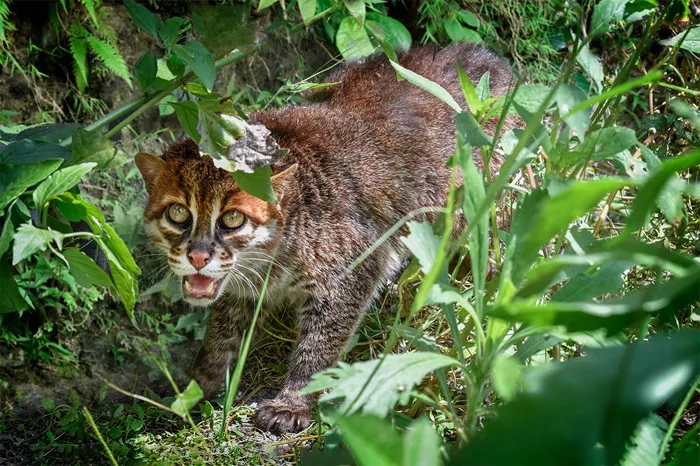The flat-headed cat (Prionailurus planiceps) is an enigmatic and critically endangered small felid native to Southeast Asia, specifically found in Peninsular Malaysia, Sumatra, Borneo, and southern Thailand. This small cat faces numerous threats including habitat conversion to agricultural lands (notably oil palm plantations), pollution, and hunting. Due to its elusive nature and the difficulty of capturing it on camera, significant knowledge gaps exist regarding its distribution and ecology.
Characteristics and Habitat
Weighing less than a domestic cat, the flat-headed cat is uniquely adapted to its semiaquatic and wetland habitats. It has partially retractable claws, partially webbed paws, and wide, close-set eyes that are suited for its nocturnal lifestyle. The cat’s short, stubby tail and small size allow it to navigate muddy wetlands efficiently. Its diet includes fish, amphibians, rodents, and crustaceans, making it a specialized hunter in its habitat.
Threats to Survival
The flat-headed cat is endangered primarily due to habitat loss. Rapid agricultural encroachment, particularly for oil palm plantations, has devastated its natural habitats. A significant portion of its suitable habitat has been converted or degraded, with only about 10-20% of this habitat falling within protected areas. Additional threats include pollution, hunting, road kills, and possibly disease transmission from domestic animals.
Conservation Efforts
To protect the flat-headed cat, targeted research and conservation actions are imperative. Researchers are employing various methods to gather more data about this elusive species, including radio-collaring and innovative techniques like environmental DNA (eDNA).
Radio-Collaring: In 2021, researchers successfully radio-collared a female flat-headed cat in Malaysia, providing valuable data on its range and behavior. This study revealed that the flat-headed cat has a small home range compared to other small felids, with its core area being just 500 square meters. Such data is crucial for understanding habitat needs and informing conservation strategies.
Camera Traps and eDNA: Camera trapping has yielded limited success due to the cat’s elusive nature and challenging habitats. Innovative techniques like eDNA sampling offer potential, as they can detect the presence of species through genetic material found in the environment. Although eDNA has its own limitations, such as not providing density information, it could complement traditional methods to enhance detection rates.
Conservation Action: Conservationists are planning range-wide targeted surveys and tagging efforts to better understand and protect the flat-headed cat. International collaboration and funding are essential for these initiatives. The Save Wild Cats Foundation and other organizations are working on captive-breeding programs and raising awareness at the community level to prevent habitat encroachment.
The Importance of Immediate Action
The flat-headed cat’s survival depends on immediate and targeted conservation efforts. Researchers emphasize the need to protect existing habitats and reduce threats. By applying a precautionary approach and acting on current data, conservationists hope to safeguard this rare species before it faces further decline.
Jim Sanderson of the Small Wild Cat Conservation Foundation and other experts stress the urgency of these measures. Increasing awareness and funding for small felids like the flat-headed cat is critical to preserving their pivotal role in ecosystems and preventing their extinction.
In conclusion, while the flat-headed cat remains one of the world’s most elusive and endangered felids, ongoing research and conservation efforts offer hope. With continued support and innovative approaches, there is potential to protect this unique species and ensure its survival in the wild.






















